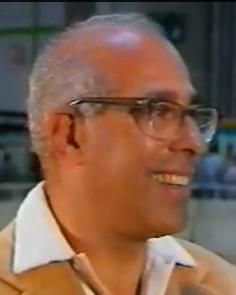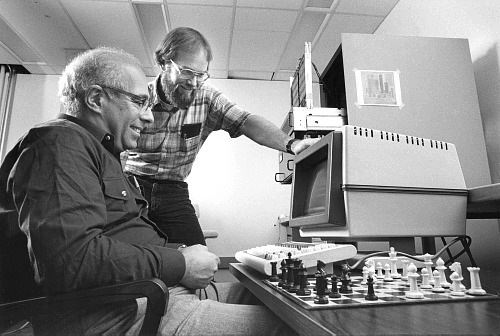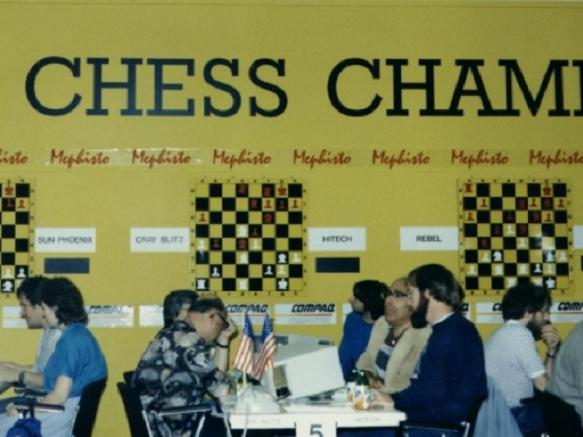Hans Berliner

Hans Jack Berliner, (January 27, 1929 - January 13, 2017)
was a German born, American Computer Scientist and Professor Emeritus from Carnegie Mellon University [2], Pittsburgh, Pennsylvania. Hans Berliner was Grandmaster of Correspondence Chess, International Master for over-the-board chess and was Correspondence Chess World Champion from 1965 until 1968.
Hans Berliner made his Ph.D. Thesis in 1974 at Carnegie Mellon about computer chess: Chess as Problem Solving: The Development of a Tactics Analyser [3] under the supervision of Allen Newell. Berliner contributed as co-author to the Technology Chess Program. He was author of the chess programs J. Biit, CAPS, Patsoc, along with Murray Campbell co-author of the chunking pawn endgame program Chunker, and lead the team in developing the HiTech chess entity - namely Carl Ebeling, Murray Campbell, Gordon Goetsch and Chris McConnell. Beside other things, Hans Berliner's research was about pattern knowledge and creation and implementation of the best-first tree search algorithm called B* [4], also used in HiTech.
Contents
Chess Programs
BKG 9.8
In the late 70s at Carnegie Mellon University, Hans Berliner developed the Backgammon playing program BKG 9.8 for the PDP-10 to research the principles of evaluation for another game than chess with a much higher branching factor of more than 800 at every node [5]. Early versions of BKG played badly even against weak players, but Berliner noticed that its critical mistakes were always at transitions apparently due to evaluation discontinuity. He applied principles of fuzzy logic to smooth out the transition between phases, and by July 1979, BKG 9.8 was strong enough to play against the ruling world champion Luigi Villa. It won the match 7–1, becoming the first computer program to defeat a world champion in any game. Berliner states that the victory was largely a matter of luck, as the computer received more favorable dice rolls [6] [7].
Photos
Hans Berliner and Carl Ebeling, developers of HiTech at Carnegie Mellon University [8]
Cray Blitz vs. HiTech, WCCC 1986 [9]
Quotes
James Gillogly
Quote by James Gillogly on Berliner's Technology Program contribution [10]:
Acknowledgements: I am indebted to Hans Berliner, World Correspondence Chess Champion, who developed the elegant techniques used in the positional analysis, and whose patient discussion helped to clarify many of the conceptional problems. The basic idea of the Technology Program is due in large part to Allen Newell.
Alex Bell
Quote by Alex Bell from his report on Advances in Computer Chess 1 [11]:
A number of experts were invited to give papers. on their work, including Dr Mikhail Donskoy of the USSR, one of the authors of the world champion program, KAISSA. Unfortunately Donskoy was unable to attend, a disappointment only mitigated by the presence from the US of Dr Hans Berliner, of Carnegie-Mellon. Berliner is the world correspondence chess champion and has also spent the last eight or nine years programming computers to play the game. To most people in the practical, model building side of the subject, ie making a program play the computer game, Berliner is THE expert. Although full of good, implementable ideas he has no illusions as to the limitations of such chess programs. -- The conference itself lasted one and a half days and the papers (depending on the listener) ranged from the profound to the puerile. I have no desire to repeat my own personal views, indeed as one of the organisers I helped to provide a platform for speakers whose views I found astonishing. What did seem evident to me was that the majority of the audience fell into one of three categories. One group is the artificial intelligentsia. They fully understand the difficulties of the problem and are still thinking about how to solve it. The second group are the let's get on and program something crunchers, the model makers, the people who can make big computers float round the room whistling God save the Queen. These people absolutely refuse to put anything remotely resembling knowledge, chess or otherwise, into their programs if they can avoid it, believing that if the result plays good chess then it can be more easily adapted to attempt other, more useful, decision making problems. The third group is the most important, these are the people who are new to the subject, the people who say, It sounds like a fascinating problem and I'd like to know what's going on.
Hans Berliner fits into two of these categories, his talk covered the AI approach and the crunchers, but he is hardly a newcomer. He was the first speaker and the domain of his talk was chess tactics with emphasis on recognising situations and dealing with them explicitly. He is full of good ideas and techniques which are relevant to the problem of selecting the right move in a game of chess and, more important, showed clearly how each idea and technique could be implemented in a computer.
Hans Berliner
Hans Berliner about his role in the HiTech team [12]:
I have been responsible for doing the pattern knowledge and most of the opening book, and acting as moderator for the many fine discussions that we have about how to improve HiTech in the various areas that need work.
See also
Selected Publications
1970 ...
- Hans Berliner (1970). Experiences Gained in Constructing and Testing a Chess Program. IEEE Symposium System Science and Cybernetics, reprinted in David Levy (ed.) (1988). Computer Games I.
- Hans Berliner (1971). 1st U.S. Computer Championship. Chess Life and Review » ACM 1970 [15]
- Hans Berliner (1973). Some Necessary Conditions for a Master Chess Program. IJCAI 1973
- Hans Berliner (1974). Chess as Problem Solving: The Development of a Tactics Analyser. Ph.D. thesis, Carnegie Mellon University
- Hans Berliner (1977). A Representation and Some Mechanisms for a Problem-Solving Chess Program. Advances in Computer Chess 1
- Hans Berliner (1977). BKG - A Program that Plays Backgammon. Technical Report, Carnegie Mellon University, reprinted in David Levy (ed.) (1988). Computer Games I.
- Hans Berliner (1977). Experiences in Evaluation with BKG, a Program That Plays Backgammon. IJCAI 1977, hosted by Backgammon Galore
- Hans Berliner, Richard Greenblatt, Jacques Pitrat, Arthur Samuel, David Slate (1977). Panel on Computer Game Playing. IJCAI 1977, pdf
- Crispin Perdue, Hans Berliner (1977). EG: a case study in problem solving with king and pawn endings. IJCAI 1977
- Hans Berliner (1977). The B* Tree Search Procedure: Best-first Search Combined with Branch and Bound. Computer Science Department. Carnegie Mellon University
- Hans Berliner (1978). A Chronology of Computer Chess and its Literature. Artificial Intelligence, No. 10, pp. 201–214.
- Hans Berliner (1979). The B*-Tree Search Algorithm - A Best-First Proof Procedure. Artificial Intelligence, Vol. 12, No. 1, pp. 23-40. ISSN 0004-3702.
- Hans Berliner (1979). On the Construction of Evaluation Functions for Large Domains. IJCAI 1979, Vol. 1, hosted by Backgammon Galore
1980 ...
- Hans Berliner (1980). Backgammon Computer Program Beats World Champion. Artificial Intelligence, Vol. 14, hosted by Backgammon Galore, reprinted in David Levy (ed.) (1988). Computer Games I.
- Hans Berliner (1980). Computer Backgammon. Scientific American, Vol. 242, No. 6, hosted by Backgammon Galore
- Hans Berliner (1981). An Examination of Brute Force Intelligence. IJCAI 1981
- Hans Berliner (1982). Search vs. knowledge: an analysis from the domain of games. Technical Report Department of Computer Science, Carnegie Mellon University
- Hans Berliner (1983). Search. Artificial Intelligence Syllabus, Department of Computer Science, Carnegie Mellon University
- Murray Campbell, Hans Berliner (1983). A Chess Program That Chunks. AAAI 1983 49-53, pdf
- Hans Berliner (1984). Search vs. knowledge: An analysis from the domain of games. In A. Elithorn and R. Banerji (Eds.), Artificial and Human Intelligence (pp. 105-117). New York, NY: Elsevier.
- Hans Berliner, Murray Campbell (1984). Using Chunking to Solve Chess Pawn Endgames. Artificial Intelligence, Vol. 23, No. 1, pp. 97-120. ISSN 0004-3702.
- Hans Berliner, Gordon Goetsch (1984). A quantitative study of search methods and the effect of constraint satisfaction, Tech. Rept. CMU-CS-84-147, Department of Computer Science, Carnegie Mellon University
- Hans Berliner, Gordon Goetsch (1985). A Study of Search Methods: The Effect of Constraint Satisfaction and Adventurousness. IJCAI 1985, pdf
- Hans Berliner (1985). Computer Chess at Carnegie Mellon University. Advances in Computer Chess 4
- Hans Berliner (1985). Goals, Plans, and Mechanisms: Non-symbolically in an Evaluation Surface. Presentation at Evolution, Games, and Learning, Center for Nonlinear Studies, Los Alamos National Laboratory, May 21.
- Hans Berliner (1985). HiTech wins North American Computer-Chess Championship. ICCA Journal, Vol. 8, No. 4 » ACM 1985
- Hans Berliner (1985). The 1985 Fredkin Competition. ICCA Journal, Vol. 8, No. 4
- Hans Berliner, Carl Ebeling (1986). The SUPREM Architecture: a new Intelligent Paradigm. Artificial Intelligence, Vol. 28, No. 1, pp. 3-8.
- Hans Berliner (1987). Some Innovations Introduced by Hitech. ICCA Journal, Vol. 10, No. 3
- Hans Berliner (1988). Pennsyvania State Chess Championship - HiTech Becomes First Computer Senior Master. AI Magazine Volume 9 Number 3 (© AAAI), pdf
- Hans Berliner (1989). What is still needed in Game Tree Search. Workshop on New Directions in Game-Tree Search
- Hans Berliner (1989). Some Innovations Introduced by Hitech. Advances in Computer Chess 5
- Hans Berliner, Gordon Goetsch, Murray Campbell, Carl Ebeling (1989). Measuring the Performance Potential of Chess Programs. Advances in Computer Chess 5
- Hans Berliner (1989). The Human versus Computer Match 1989. ICCA Journal, Vol. 12, No. 3 » Aegon 1989
- Hans Berliner (1989). Deep Thought Wins Fredkin Intermediate Prize. AI Magazine Volume 10 Number 2, pdf
- Hans Berliner, Carl Ebeling (1989). Pattern Knowledge and Search: The SUPREM Architecture. Artificial Intelligence, Vol. 38, No. 2, pp. 161-198. ISSN 0004-3702.
- Revised as Hans Berliner, Carl Ebeling (1990). Hitech. Computers, Chess, and Cognition
1990 ...
- Hans Berliner, Carl Ebeling (1990). Hitech. Computers, Chess, and Cognition
- Hans Berliner, Gordon Goetsch, Murray Campbell, Carl Ebeling (1990). Measuring the Performance Potential of Chess Programs. Artificial Intelligence, Vol. 43, No. 1
- Hans Berliner, Danny Kopec, Ed Northam (1991). A taxonomy of concepts for evaluating chess strength: examples from two difficult categories. Advances in Computer Chess 6, pdf
- Hans Berliner (1992). Allen Newell 1927-1992, In Memoriam. ICCA Journal, Vol. 15, No. 3
- Hans Berliner (1993). Losing the Human Edge. BYTE, May, p. 282.
- Hans Berliner (1993). Playing Computer Chess in the Human Style. ICCA Journal, Vol. 16, No. 3 » CC Sapiens
- Critique about Mikhail Botvinnik [16] [17] [18]
- Hans Berliner, Chris McConnell (1995). B* Probability Based Search. Carnegie Mellon University, ps
- Hans Berliner (1996). Why did Kasparov Blink? ICCA Journal, Vol. 19, No. 2 » Kasparov versus Deep Blue 1996 [19]
- Hans Berliner, Chris McConnell (1996). B* probability based search. Artificial Intelligence, Vol. 86, No. 1 pp. 97-156. ISSN 0004-3702.
- Hans Berliner (1999). The System: A World Champion's Approach to Chess. Gambit Publications, ISBN 1-901983-10-2 [20][21][22]
2000 ...
- Hans Berliner (2001). HERBERT A. SIMON (1916-2001): A LIFE'S APPRAISAL. ICCA Journal, Vol. 24, No. 1
- Gardner Hendrie (2005). Oral History of Hans Berliner. pdf and video from The Computer History Museum
External Links
- Hans Berliner from Wikipedia
- World Chess Hall of Fame: Hans Berliner
- Hans Berliner's ICGA tournaments
- chessgames.com - games of Hans Berliner
- Chess piece value, the Hans Berliner's system from Wikipedia
Oral History
- Oral History of Hans Berliner, Interviewed by Gardner Hendrie, March 7, 2005, The Computer History Museum, pdf
Eulogies
- Hans Berliner, Master Chess Player and Programmer, Dies at 87 by Dylan Loeb McClain, The New York Times, January 16, 2017 [23]
- Hans Berliner, chess master and programmer, dies at 87 by Frederic Friedel, ChessBase New, January 18, 2017
References
- ↑ WCCC 1986 Video capture at 24:34 during interview by Albrecht Fölsing at 24:14 before the final game Cray Blitz vs. HiTech
- ↑ Carnegie Mellon, School of Computer Science
- ↑ Hans Berliner (1974). Chess as Problem Solving: The Development of a Tactics Analyser. Ph.D. thesis, Carnegie Mellon University
- ↑ The B* tree search algorithm: A best-first proof procedure from ScienceDirect.com
- ↑ Hans Berliner (1977). Experiences in Evaluation with BKG, a Program That Plays Backgammon. IJCAI 1977, hosted by Backgammon Galore
- ↑ Hans Berliner from Wikipedia
- ↑ Hans Berliner (1980). Backgammon Computer Program Beats World Champion. Artificial Intelligence, Vol. 14
- ↑ Photo ca 1985, © Bill Redick, History of Computer Chess from The Computer History Museum
- ↑ Cray Blitz vs. HiTech, WCCC 1986, Photo from Historic Pictures by Ed Schröder
- ↑ James Gillogly (1972). The Technology Chess Program. Artificial Intelligence, Vol. 3, pp. 145-163. ISSN 0004-3702. Reprinted (1988) in Computer Chess Compendium
- ↑ 1975 Press Releases - Techniques for playing the end game from Atlas Computer Laboratory, hosted by Rutherford Appleton Laboratory (RAL)
- ↑ Hans Berliner (1988). Pennsyvania State Chess Championship - HiTech Becomes First Computer Senior Master. AI Magazine Volume 9 Number 3 (© AAAI), pdf
- ↑ DBLP: Hans J. Berliner
- ↑ ICGA Reference Database
- ↑ The First Computer Chess Championship in the USA by batgirl, Chess.com, September 20, 2017
- ↑ Kasparov missed Beautiful win; Botvinnik's Program muffs analysis by Hans Berliner, rgcc, July 9, 1993
- ↑ Hans Berliner against Mikhail Botvinnik by Alexander Timofeev
- ↑ Berliner paper about Botvinnik by Shane Hudson, rgc, September 10, 1994
- ↑ Why did Kasparov blink? by Tom King, rgcc, March 22, 1999
- ↑ White to play and win - discussion on Berliner's The System from Wikipedia
- ↑ The System: A World Champion's Approach to Chess Reviewed by Jeremy Silman
- ↑ My (the) System discussion on Berliner's The System from rgcc, January 13, 2000
- ↑ Hans Berliner, Master Chess Player and Programmer, Dies at 87 by John E Jack, CCC, January 17, 2017

